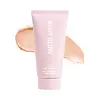What's inside
What's inside
 Key Ingredients
Key Ingredients

 Benefits
Benefits

 Concerns
Concerns

 Ingredients Side-by-side
Ingredients Side-by-side

Water
Skin ConditioningMica
Cosmetic ColorantButylene Glycol
HumectantVp/Va Copolymer
Acrylates/Beheneth-25 Methacrylate Copolymer
Glyceryl Caprylate
EmollientSodium Dehydroacetate
PreservativeAminomethyl Propanol
BufferingGlycerin
HumectantCaprylhydroxamic Acid
Alumina
AbrasiveHydrogen Peroxide
AntimicrobialTin Oxide
AbrasiveCI 77891
Cosmetic ColorantCI 77491
Cosmetic ColorantCI 77492
Cosmetic ColorantCI 77499
Cosmetic ColorantCoco-Caprylate/Caprate
EmollientMacadamia Integrifolia Seed Oil
Skin ConditioningDicaprylyl Ether
EmollientCaprylic/Capric Triglyceride
MaskingPrunus Amygdalus Dulcis Oil
Skin ConditioningCorylus Avellana Seed Oil
EmollientMica
Cosmetic ColorantCamellia Oleifera Seed Oil
Skin ConditioningParfum
MaskingCamellia Japonica Seed Oil
EmollientCastor Oil/Ipdi Copolymer
CI 77891
Cosmetic ColorantArgania Spinosa Kernel Oil
EmollientBorago Officinalis Seed Oil
EmollientTocopherol
AntioxidantCI 77491
Cosmetic ColorantHelianthus Annuus Seed Oil
EmollientTocopheryl Acetate
AntioxidantRosmarinus Officinalis Leaf Extract
AntimicrobialPolyglyceryl-3 Diisostearate
EmulsifyingWater
Skin ConditioningAscorbic Acid
AntioxidantSolanum Lycopersicum Fruit Extract
AntioxidantLinalool
PerfumingLimonene
PerfumingCitronellol
PerfumingGeraniol
PerfumingCoco-Caprylate/Caprate, Macadamia Integrifolia Seed Oil, Dicaprylyl Ether, Caprylic/Capric Triglyceride, Prunus Amygdalus Dulcis Oil, Corylus Avellana Seed Oil, Mica, Camellia Oleifera Seed Oil, Parfum, Camellia Japonica Seed Oil, Castor Oil/Ipdi Copolymer, CI 77891, Argania Spinosa Kernel Oil, Borago Officinalis Seed Oil, Tocopherol, CI 77491, Helianthus Annuus Seed Oil, Tocopheryl Acetate, Rosmarinus Officinalis Leaf Extract, Polyglyceryl-3 Diisostearate, Water, Ascorbic Acid, Solanum Lycopersicum Fruit Extract, Linalool, Limonene, Citronellol, Geraniol
Ingredients Explained
These ingredients are found in both products.
Ingredients higher up in an ingredient list are typically present in a larger amount.
Ci 77491 is also hydrated iron III oxide. It's sole purpose is to give a red/pink hue to products.
Iron III oxides are classified as inorganic chemicals for coloring.
Synthetically created Ci 77491 is considered safer than those naturally found. This is because the synthetically created version may contain less impurities. Iron oxides are generally non-toxic and non-allergenic.
Learn more about CI 77491Ci 77891 is a white pigment from Titanium dioxide. It is naturally found in minerals such as rutile and ilmenite.
It's main function is to add a white color to cosmetics. It can also be mixed with other colors to create different shades.
Ci 77891 is commonly found in sunscreens due to its ability to block UV rays.
Learn more about CI 77891Mica is a naturally occurring mineral used to add shimmer and color in cosmetics. It can also help improve the texture of a product or give it an opaque, white/silver color.
Serecite is the name for very fine but ragged grains of mica.
This ingredient is often coated with metal oxides like titanium dioxide. Trace amounts of heavy metals may be found in mica, but these metals are not harmful in our personal products.
Mica has been used since prehistoric times throughout the world. Ancient Egyptian, Indian, Greek, Roman, Aztec, and Chinese civilizations have used mica.
Learn more about MicaWater. It's the most common cosmetic ingredient of all. You'll usually see it at the top of ingredient lists, meaning that it makes up the largest part of the product.
So why is it so popular? Water most often acts as a solvent - this means that it helps dissolve other ingredients into the formulation.
You'll also recognize water as that liquid we all need to stay alive. If you see this, drink a glass of water. Stay hydrated!
Learn more about Water